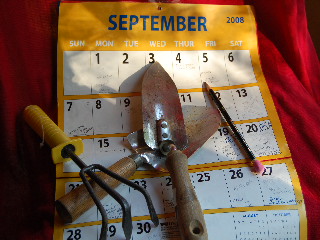
Keeping a log of planting, pruning, and maintaining your home landscaping and gardening areas can help you create a master plan for future care of your grounds. This will make the whole thing a lot easier from year to year.
As you establish your garden, you need to anticipate and schedule maintenance. You can do this by creating your own master plan as you go along. Keeping a record of what you do and when you do it this year will help you anticipate the right things to do and the right times to do them next year.
Only two items are needed in order to create your master plan. Start with a basic calendar, either a wall calendar with large spaces into which you can write your anticipated daily activities, or a calendar you create on your computer. Item number two on your list of materials needed is a logbook. This, too, can be either a hardcopy paper item such as a 3-ring notebook or a spiral notebook, or a computer log into which you enter the activities as you actually complete them.
Whether you are planning a vegetable garden or flower garden, or just seeking to maintain and improve your home landscaping, you can pick up valuable clues as to what you should currently be working on by making regular visits to your local garden centers and home improvement stores. If they are beginning to stock lots of spring-flowering bulbs, chances are it’s not spring at all, but autumn and the proper time to start selecting those bulbs and getting them into the ground so they’ll over-winter properly in your garden soil and reward you with a nice showing of spring flowers.
If the garden centers are heavily stocked with flats of colorful annuals of every variety suitable to growing in your zone, chances are the blooms on your bulbs are starting to fade and it’s probably a good idea to think about planting annuals. When flats of pansies adorn the shelves, maybe it’s starting to be the ideal time of year to plant pansies.
The same holds true for fruit trees, shade trees, and landscaping shrubs of all varieties; whatever the garden centers currently have on hand is most likely suitable for planting at the current time. You get the idea!
The vendors want you to succeed so you’ll return and purchase more plant material for your garden in the future. Besides, it’s always fun to make regular stops at the garden center, anyway, just to check on what’s new and colorful and in stock that you might want to incorporate into your garden design.
In addition to adding plants into your landscape at the proper time, you also need to prune and feed them at the proper time of the year in order to maximize success. The timing of these tasks might be a little tricky for the first couple of years, but this is where keeping a daily log of what you actually do becomes very valuable in establishing plans for future years. Write down when you prune, when you fertilize, and the conditions at the time of these activities. Is it cooler than usual, rainier than usual; are you having a very hot summer with drought conditions? Weather conditions will certainly affect the way your plants respond to your acts of maintenance. Observe (and record in your logbook) how your plants respond in the days and weeks after pruning or feeding. Should you have acted sooner or later in order to gain the maximum benefit for your plants?
As an example, if you prune last year’s growth from your liriope in late March, and observe that your act of pruning damages the tender new growth that has already started, make a note of this and schedule your pruning for a little bit earlier date next year.
In recording everything you do in the garden, when you do it, and how your garden responds, you are creating your master plan. Refine your plan as you go along by making notes as the years go by. Soon you’ll be able to anticipate almost everything you need to do in order to have a beautifully growing garden that flows successfully from season to season, maximizing your bounty of flowers, vegetables, fruits, shade, greenery, or whatever it is you are seeking to harvest from your garden.
 Keeping a log of planting, pruning, and maintaining your home landscaping and gardening areas can help you create a master plan for future care of your grounds. This will make the whole thing a lot easier from year to year.
Keeping a log of planting, pruning, and maintaining your home landscaping and gardening areas can help you create a master plan for future care of your grounds. This will make the whole thing a lot easier from year to year.